Team Effectiveness: Leadership, Management, and Performance Report
VerifiedAdded on 2021/04/21
|19
|4060
|57
Report
AI Summary
This report examines the challenges of leading and managing a team, focusing on a jewelry firm's issues with team dynamics and productivity. The report highlights the importance of effective leadership in fostering communication, cooperation, and a shared vision among employees. It explores Tuckman's stages of team development (forming, storming, norming, performing, and adjourning) and emphasizes the significance of team goals, skills, and competency. The report analyzes the role of organizational goals, KPIs, and individual performance in driving team effectiveness, as well as the importance of planning, decision-making, performance evaluations, rewards, and conflict resolution. It stresses the role of communication, motivation, and team leader effectiveness in achieving organizational success. The report concludes with recommendations for improving team performance, including enhanced communication, training, and recognition programs.

Running head: LEADING AND MANAGING TEAM EFFECTIVENESS
LEADING AND MANAGING TEAM EFFECTIVENESS
Name of the Student
Name of the University
Author Note
LEADING AND MANAGING TEAM EFFECTIVENESS
Name of the Student
Name of the University
Author Note
Paraphrase This Document
Need a fresh take? Get an instant paraphrase of this document with our AI Paraphraser
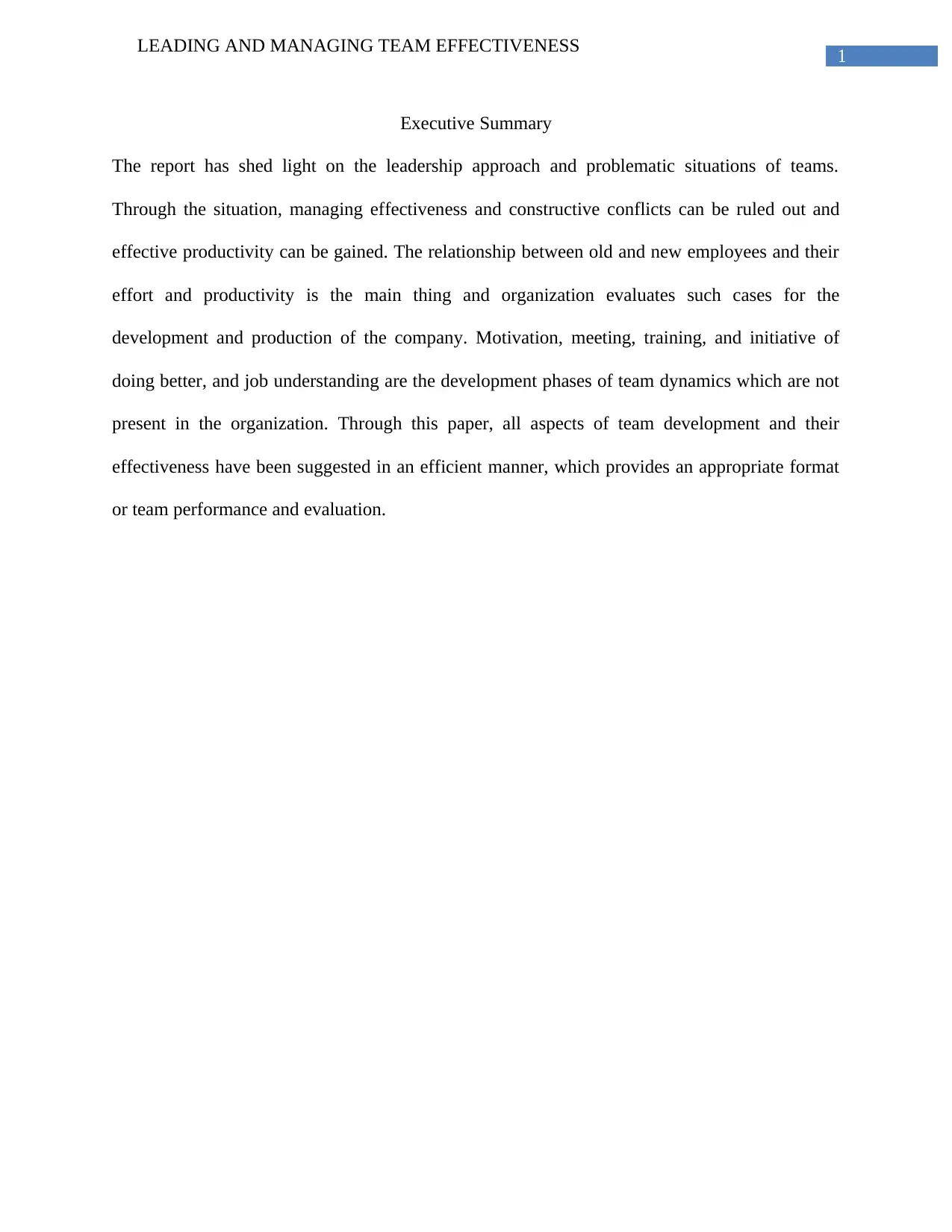
1
LEADING AND MANAGING TEAM EFFECTIVENESS
Executive Summary
The report has shed light on the leadership approach and problematic situations of teams.
Through the situation, managing effectiveness and constructive conflicts can be ruled out and
effective productivity can be gained. The relationship between old and new employees and their
effort and productivity is the main thing and organization evaluates such cases for the
development and production of the company. Motivation, meeting, training, and initiative of
doing better, and job understanding are the development phases of team dynamics which are not
present in the organization. Through this paper, all aspects of team development and their
effectiveness have been suggested in an efficient manner, which provides an appropriate format
or team performance and evaluation.
LEADING AND MANAGING TEAM EFFECTIVENESS
Executive Summary
The report has shed light on the leadership approach and problematic situations of teams.
Through the situation, managing effectiveness and constructive conflicts can be ruled out and
effective productivity can be gained. The relationship between old and new employees and their
effort and productivity is the main thing and organization evaluates such cases for the
development and production of the company. Motivation, meeting, training, and initiative of
doing better, and job understanding are the development phases of team dynamics which are not
present in the organization. Through this paper, all aspects of team development and their
effectiveness have been suggested in an efficient manner, which provides an appropriate format
or team performance and evaluation.
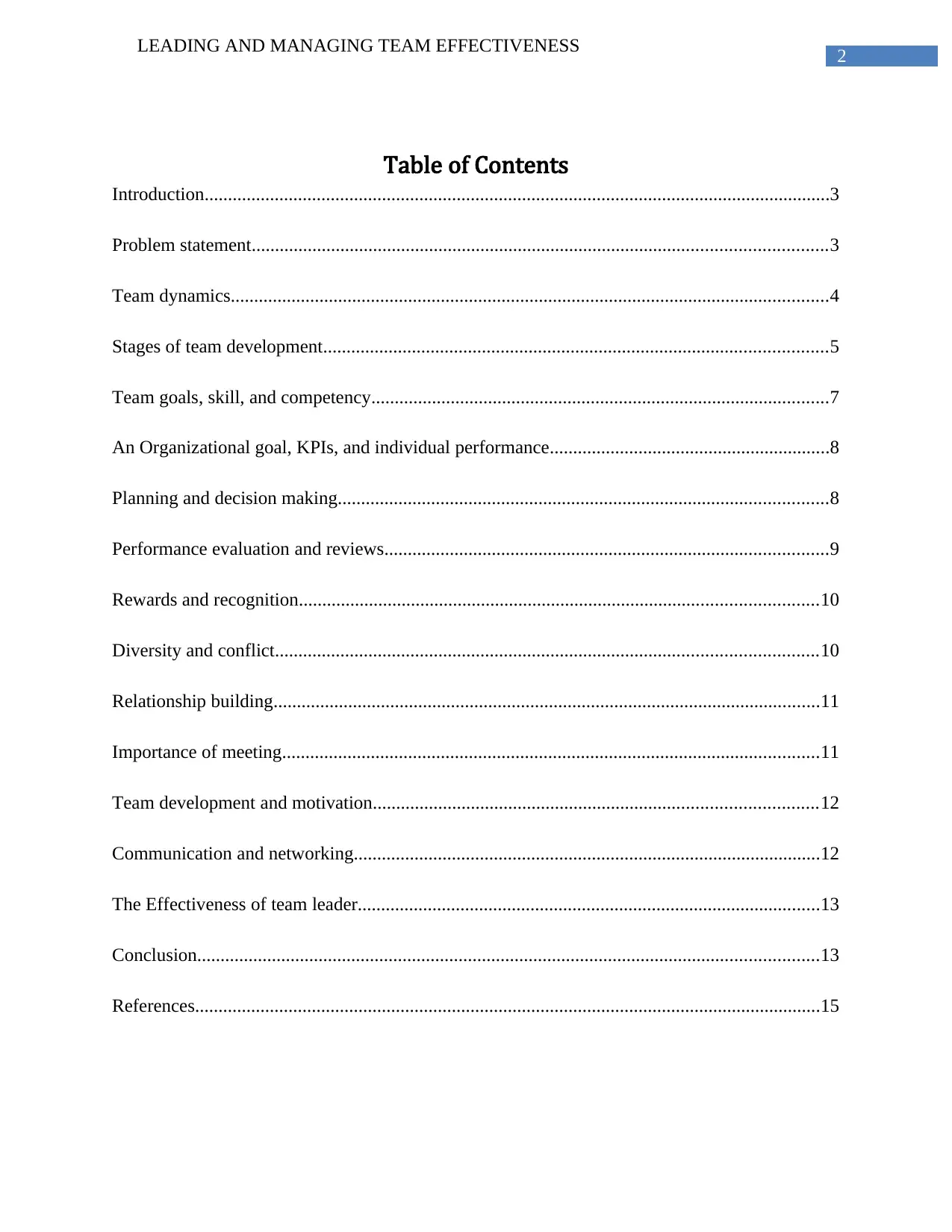
2
LEADING AND MANAGING TEAM EFFECTIVENESS
Table of Contents
Introduction......................................................................................................................................3
Problem statement...........................................................................................................................3
Team dynamics................................................................................................................................4
Stages of team development............................................................................................................5
Team goals, skill, and competency..................................................................................................7
An Organizational goal, KPIs, and individual performance............................................................8
Planning and decision making.........................................................................................................8
Performance evaluation and reviews...............................................................................................9
Rewards and recognition...............................................................................................................10
Diversity and conflict....................................................................................................................10
Relationship building.....................................................................................................................11
Importance of meeting...................................................................................................................11
Team development and motivation...............................................................................................12
Communication and networking....................................................................................................12
The Effectiveness of team leader...................................................................................................13
Conclusion.....................................................................................................................................13
References......................................................................................................................................15
LEADING AND MANAGING TEAM EFFECTIVENESS
Table of Contents
Introduction......................................................................................................................................3
Problem statement...........................................................................................................................3
Team dynamics................................................................................................................................4
Stages of team development............................................................................................................5
Team goals, skill, and competency..................................................................................................7
An Organizational goal, KPIs, and individual performance............................................................8
Planning and decision making.........................................................................................................8
Performance evaluation and reviews...............................................................................................9
Rewards and recognition...............................................................................................................10
Diversity and conflict....................................................................................................................10
Relationship building.....................................................................................................................11
Importance of meeting...................................................................................................................11
Team development and motivation...............................................................................................12
Communication and networking....................................................................................................12
The Effectiveness of team leader...................................................................................................13
Conclusion.....................................................................................................................................13
References......................................................................................................................................15
⊘ This is a preview!⊘
Do you want full access?
Subscribe today to unlock all pages.

Trusted by 1+ million students worldwide
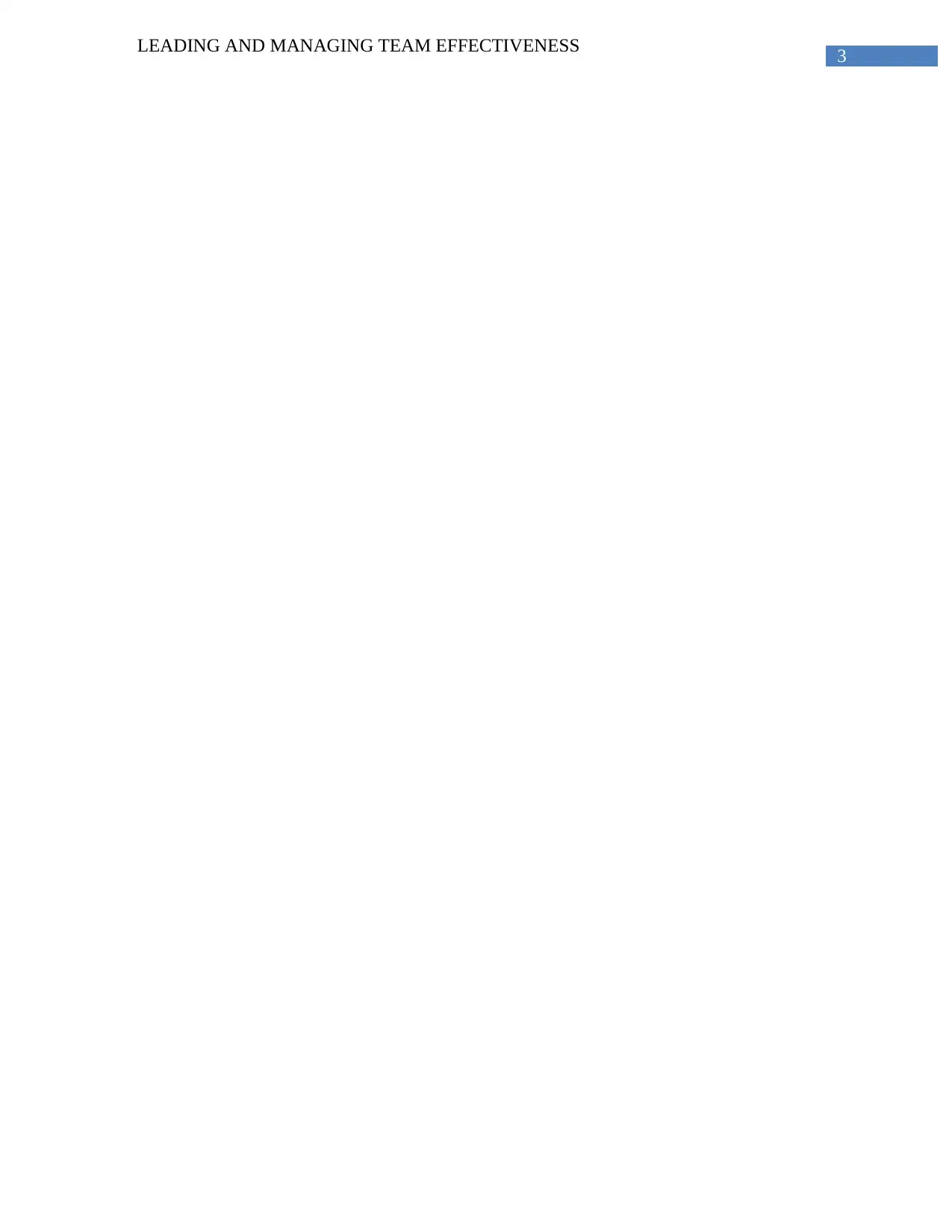
3
LEADING AND MANAGING TEAM EFFECTIVENESS
LEADING AND MANAGING TEAM EFFECTIVENESS
Paraphrase This Document
Need a fresh take? Get an instant paraphrase of this document with our AI Paraphraser
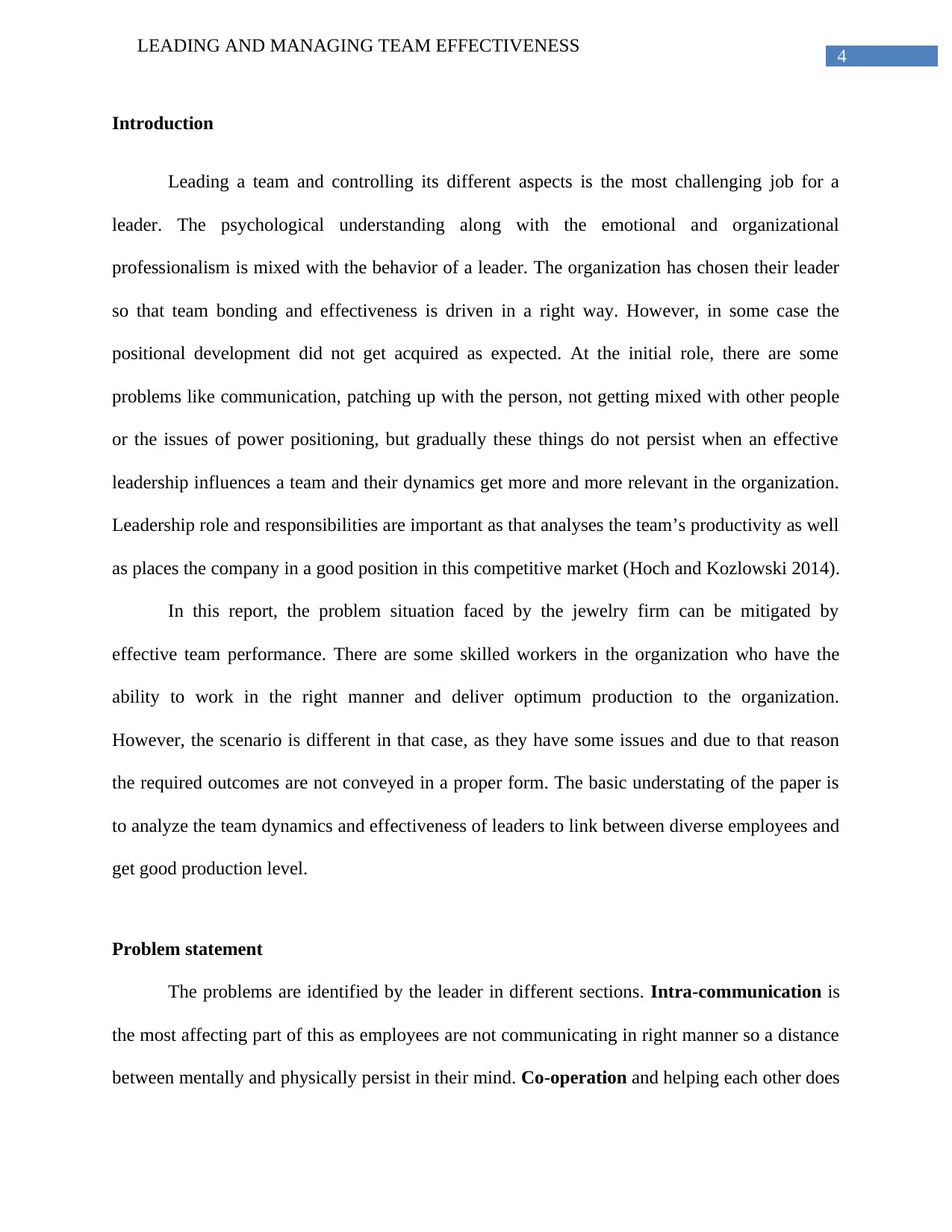
4
LEADING AND MANAGING TEAM EFFECTIVENESS
Introduction
Leading a team and controlling its different aspects is the most challenging job for a
leader. The psychological understanding along with the emotional and organizational
professionalism is mixed with the behavior of a leader. The organization has chosen their leader
so that team bonding and effectiveness is driven in a right way. However, in some case the
positional development did not get acquired as expected. At the initial role, there are some
problems like communication, patching up with the person, not getting mixed with other people
or the issues of power positioning, but gradually these things do not persist when an effective
leadership influences a team and their dynamics get more and more relevant in the organization.
Leadership role and responsibilities are important as that analyses the team’s productivity as well
as places the company in a good position in this competitive market (Hoch and Kozlowski 2014).
In this report, the problem situation faced by the jewelry firm can be mitigated by
effective team performance. There are some skilled workers in the organization who have the
ability to work in the right manner and deliver optimum production to the organization.
However, the scenario is different in that case, as they have some issues and due to that reason
the required outcomes are not conveyed in a proper form. The basic understating of the paper is
to analyze the team dynamics and effectiveness of leaders to link between diverse employees and
get good production level.
Problem statement
The problems are identified by the leader in different sections. Intra-communication is
the most affecting part of this as employees are not communicating in right manner so a distance
between mentally and physically persist in their mind. Co-operation and helping each other does
LEADING AND MANAGING TEAM EFFECTIVENESS
Introduction
Leading a team and controlling its different aspects is the most challenging job for a
leader. The psychological understanding along with the emotional and organizational
professionalism is mixed with the behavior of a leader. The organization has chosen their leader
so that team bonding and effectiveness is driven in a right way. However, in some case the
positional development did not get acquired as expected. At the initial role, there are some
problems like communication, patching up with the person, not getting mixed with other people
or the issues of power positioning, but gradually these things do not persist when an effective
leadership influences a team and their dynamics get more and more relevant in the organization.
Leadership role and responsibilities are important as that analyses the team’s productivity as well
as places the company in a good position in this competitive market (Hoch and Kozlowski 2014).
In this report, the problem situation faced by the jewelry firm can be mitigated by
effective team performance. There are some skilled workers in the organization who have the
ability to work in the right manner and deliver optimum production to the organization.
However, the scenario is different in that case, as they have some issues and due to that reason
the required outcomes are not conveyed in a proper form. The basic understating of the paper is
to analyze the team dynamics and effectiveness of leaders to link between diverse employees and
get good production level.
Problem statement
The problems are identified by the leader in different sections. Intra-communication is
the most affecting part of this as employees are not communicating in right manner so a distance
between mentally and physically persist in their mind. Co-operation and helping each other does
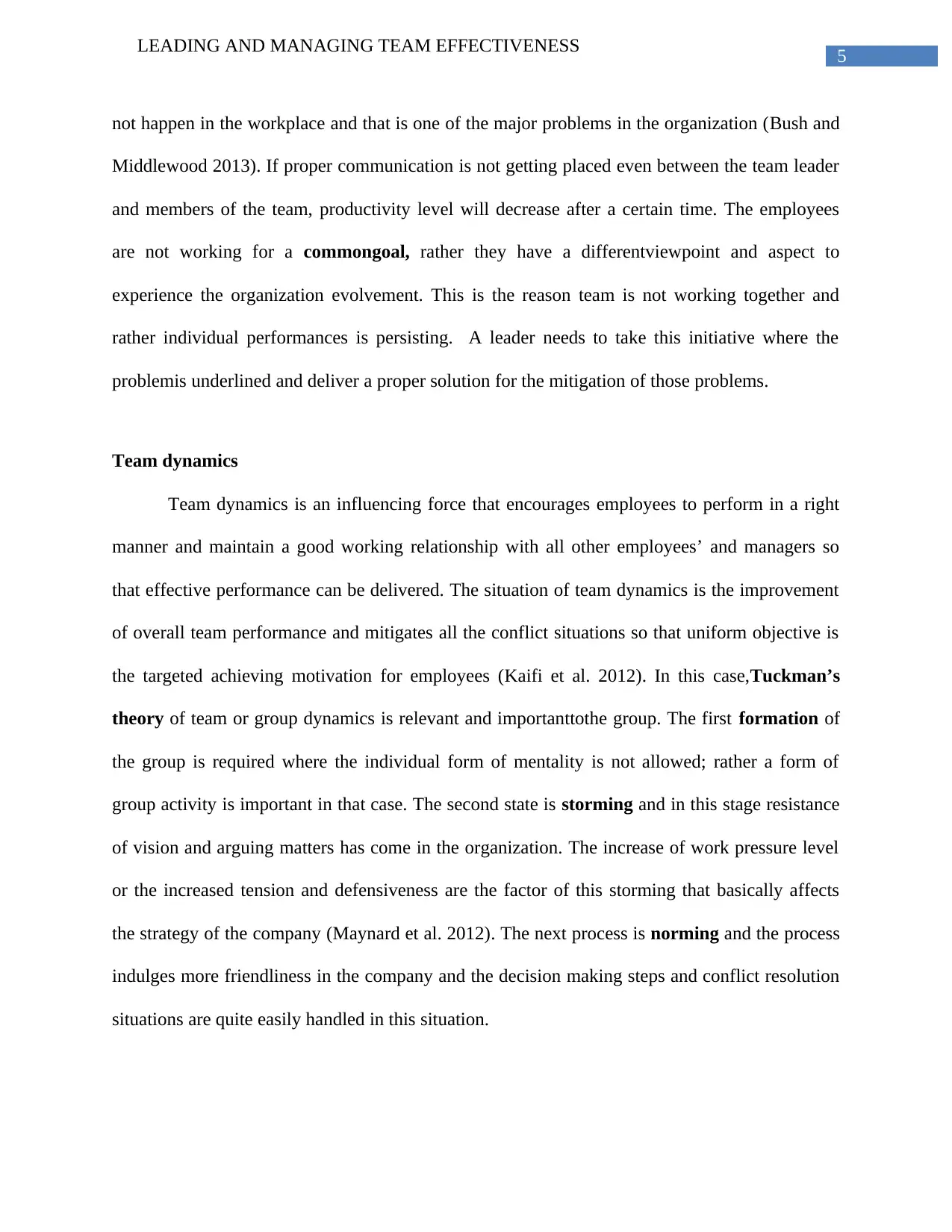
5
LEADING AND MANAGING TEAM EFFECTIVENESS
not happen in the workplace and that is one of the major problems in the organization (Bush and
Middlewood 2013). If proper communication is not getting placed even between the team leader
and members of the team, productivity level will decrease after a certain time. The employees
are not working for a commongoal, rather they have a differentviewpoint and aspect to
experience the organization evolvement. This is the reason team is not working together and
rather individual performances is persisting. A leader needs to take this initiative where the
problemis underlined and deliver a proper solution for the mitigation of those problems.
Team dynamics
Team dynamics is an influencing force that encourages employees to perform in a right
manner and maintain a good working relationship with all other employees’ and managers so
that effective performance can be delivered. The situation of team dynamics is the improvement
of overall team performance and mitigates all the conflict situations so that uniform objective is
the targeted achieving motivation for employees (Kaifi et al. 2012). In this case,Tuckman’s
theory of team or group dynamics is relevant and importanttothe group. The first formation of
the group is required where the individual form of mentality is not allowed; rather a form of
group activity is important in that case. The second state is storming and in this stage resistance
of vision and arguing matters has come in the organization. The increase of work pressure level
or the increased tension and defensiveness are the factor of this storming that basically affects
the strategy of the company (Maynard et al. 2012). The next process is norming and the process
indulges more friendliness in the company and the decision making steps and conflict resolution
situations are quite easily handled in this situation.
LEADING AND MANAGING TEAM EFFECTIVENESS
not happen in the workplace and that is one of the major problems in the organization (Bush and
Middlewood 2013). If proper communication is not getting placed even between the team leader
and members of the team, productivity level will decrease after a certain time. The employees
are not working for a commongoal, rather they have a differentviewpoint and aspect to
experience the organization evolvement. This is the reason team is not working together and
rather individual performances is persisting. A leader needs to take this initiative where the
problemis underlined and deliver a proper solution for the mitigation of those problems.
Team dynamics
Team dynamics is an influencing force that encourages employees to perform in a right
manner and maintain a good working relationship with all other employees’ and managers so
that effective performance can be delivered. The situation of team dynamics is the improvement
of overall team performance and mitigates all the conflict situations so that uniform objective is
the targeted achieving motivation for employees (Kaifi et al. 2012). In this case,Tuckman’s
theory of team or group dynamics is relevant and importanttothe group. The first formation of
the group is required where the individual form of mentality is not allowed; rather a form of
group activity is important in that case. The second state is storming and in this stage resistance
of vision and arguing matters has come in the organization. The increase of work pressure level
or the increased tension and defensiveness are the factor of this storming that basically affects
the strategy of the company (Maynard et al. 2012). The next process is norming and the process
indulges more friendliness in the company and the decision making steps and conflict resolution
situations are quite easily handled in this situation.
⊘ This is a preview!⊘
Do you want full access?
Subscribe today to unlock all pages.

Trusted by 1+ million students worldwide

6
LEADING AND MANAGING TEAM EFFECTIVENESS
Figure 1:Tuckman’s theory of Team development
(Source: Cheng 2013)
The selection of roles and responsibilities along with the belief in success has been
analyzed in this section and that basically personifies the constructive upgradation of the team.
The last section is performing and where beginning of result oriented vision and strategy has
been formed. The attachment with the team and their internal problems are highlighted in this
section but the working culture is continuing throughout the process and the newly implemented
processing are strategies that are initiated so that effective level of performance can evolve.
Stages of team development
Stages Development aspects
Forming The stage is the initial level of development of every individual. The
process begins with observing other team member and then individual
thinking for their inputs and values to the team so that emotional
attachment is formed due to that reason (Ohland et al. 2012). The stage
is full of anxiety and excitement for the new members and through this
LEADING AND MANAGING TEAM EFFECTIVENESS
Figure 1:Tuckman’s theory of Team development
(Source: Cheng 2013)
The selection of roles and responsibilities along with the belief in success has been
analyzed in this section and that basically personifies the constructive upgradation of the team.
The last section is performing and where beginning of result oriented vision and strategy has
been formed. The attachment with the team and their internal problems are highlighted in this
section but the working culture is continuing throughout the process and the newly implemented
processing are strategies that are initiated so that effective level of performance can evolve.
Stages of team development
Stages Development aspects
Forming The stage is the initial level of development of every individual. The
process begins with observing other team member and then individual
thinking for their inputs and values to the team so that emotional
attachment is formed due to that reason (Ohland et al. 2012). The stage
is full of anxiety and excitement for the new members and through this
Paraphrase This Document
Need a fresh take? Get an instant paraphrase of this document with our AI Paraphraser

7
LEADING AND MANAGING TEAM EFFECTIVENESS
process,the formation has been done.
Storming In this case, all conflict situationsarise as the level of mentalities is not
matched in an effective way. The diverse situation in the organization is
a healthy process to grow as people related form all the genres are there
however at the initial level their understanding will not match and some
of the employees have some grudge over the solution process. The
direction of success are defined in individual perspectives which are not
required in case of developing team dynamics rather directing over a
single objective is the main issue of storming.
Norming In this state organizational hierarchy has been established. The states
forms in a good position rather than storming and all the conflict
situation has gone and each member values other and respect from both
the ends continues in that section (Gundersen, Hellesøyand Raeder
2012). All the positivity norms are the important aspect of the norming
that positional difference is the major factor in the organization.
Performing The progress association and settle to redefine the target and
achievement is the major aspect of this stage. The stage highlights the
shared goal that employees are doing from their perspective to achieve
the objective of the organization.
Adjourning After the end of the project, a position will come where disengagement
of the team often happens. The reason behind the separation is the
emotional detachment of employees. If employees are emotionally
strong and they have a good attachment then the process of separation or
LEADING AND MANAGING TEAM EFFECTIVENESS
process,the formation has been done.
Storming In this case, all conflict situationsarise as the level of mentalities is not
matched in an effective way. The diverse situation in the organization is
a healthy process to grow as people related form all the genres are there
however at the initial level their understanding will not match and some
of the employees have some grudge over the solution process. The
direction of success are defined in individual perspectives which are not
required in case of developing team dynamics rather directing over a
single objective is the main issue of storming.
Norming In this state organizational hierarchy has been established. The states
forms in a good position rather than storming and all the conflict
situation has gone and each member values other and respect from both
the ends continues in that section (Gundersen, Hellesøyand Raeder
2012). All the positivity norms are the important aspect of the norming
that positional difference is the major factor in the organization.
Performing The progress association and settle to redefine the target and
achievement is the major aspect of this stage. The stage highlights the
shared goal that employees are doing from their perspective to achieve
the objective of the organization.
Adjourning After the end of the project, a position will come where disengagement
of the team often happens. The reason behind the separation is the
emotional detachment of employees. If employees are emotionally
strong and they have a good attachment then the process of separation or
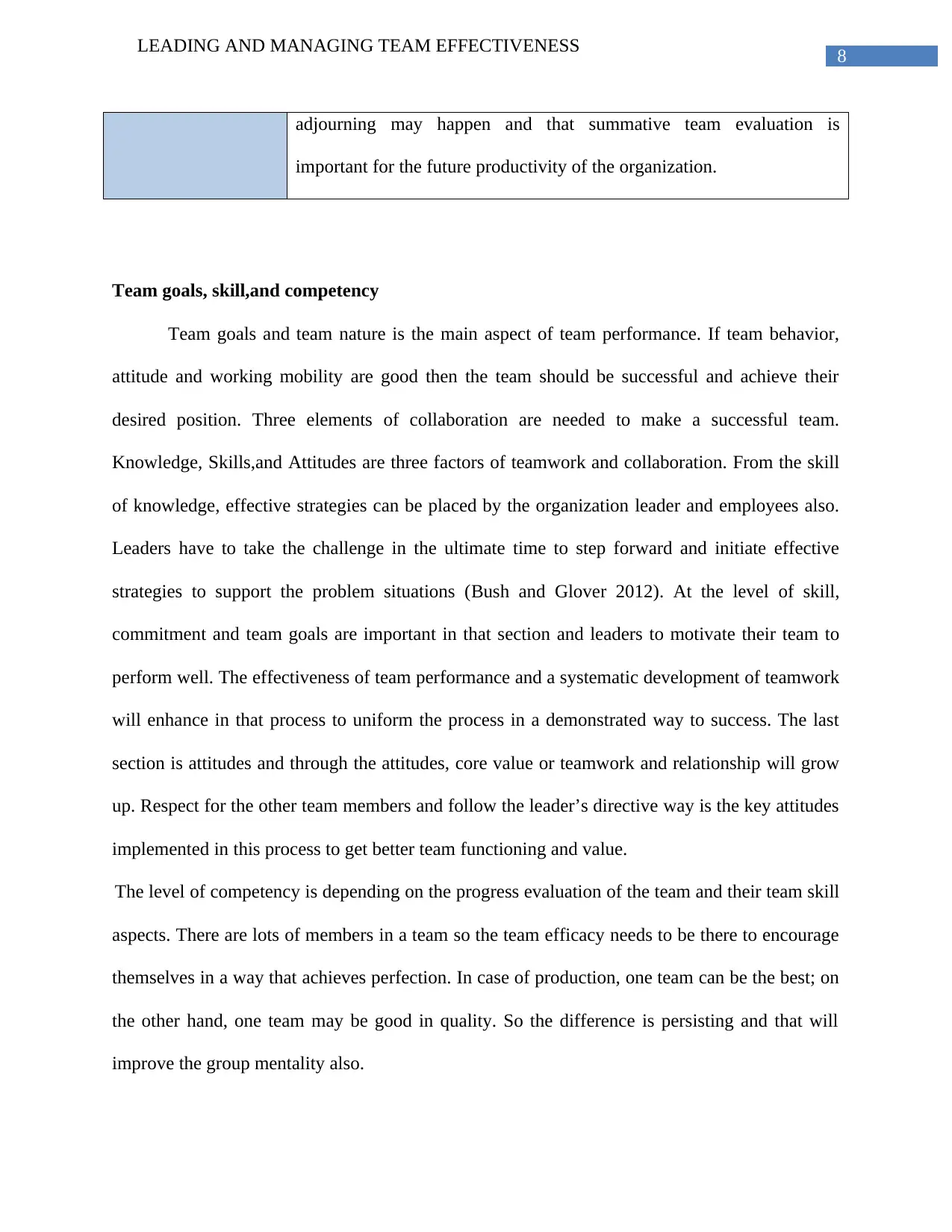
8
LEADING AND MANAGING TEAM EFFECTIVENESS
adjourning may happen and that summative team evaluation is
important for the future productivity of the organization.
Team goals, skill,and competency
Team goals and team nature is the main aspect of team performance. If team behavior,
attitude and working mobility are good then the team should be successful and achieve their
desired position. Three elements of collaboration are needed to make a successful team.
Knowledge, Skills,and Attitudes are three factors of teamwork and collaboration. From the skill
of knowledge, effective strategies can be placed by the organization leader and employees also.
Leaders have to take the challenge in the ultimate time to step forward and initiate effective
strategies to support the problem situations (Bush and Glover 2012). At the level of skill,
commitment and team goals are important in that section and leaders to motivate their team to
perform well. The effectiveness of team performance and a systematic development of teamwork
will enhance in that process to uniform the process in a demonstrated way to success. The last
section is attitudes and through the attitudes, core value or teamwork and relationship will grow
up. Respect for the other team members and follow the leader’s directive way is the key attitudes
implemented in this process to get better team functioning and value.
The level of competency is depending on the progress evaluation of the team and their team skill
aspects. There are lots of members in a team so the team efficacy needs to be there to encourage
themselves in a way that achieves perfection. In case of production, one team can be the best; on
the other hand, one team may be good in quality. So the difference is persisting and that will
improve the group mentality also.
LEADING AND MANAGING TEAM EFFECTIVENESS
adjourning may happen and that summative team evaluation is
important for the future productivity of the organization.
Team goals, skill,and competency
Team goals and team nature is the main aspect of team performance. If team behavior,
attitude and working mobility are good then the team should be successful and achieve their
desired position. Three elements of collaboration are needed to make a successful team.
Knowledge, Skills,and Attitudes are three factors of teamwork and collaboration. From the skill
of knowledge, effective strategies can be placed by the organization leader and employees also.
Leaders have to take the challenge in the ultimate time to step forward and initiate effective
strategies to support the problem situations (Bush and Glover 2012). At the level of skill,
commitment and team goals are important in that section and leaders to motivate their team to
perform well. The effectiveness of team performance and a systematic development of teamwork
will enhance in that process to uniform the process in a demonstrated way to success. The last
section is attitudes and through the attitudes, core value or teamwork and relationship will grow
up. Respect for the other team members and follow the leader’s directive way is the key attitudes
implemented in this process to get better team functioning and value.
The level of competency is depending on the progress evaluation of the team and their team skill
aspects. There are lots of members in a team so the team efficacy needs to be there to encourage
themselves in a way that achieves perfection. In case of production, one team can be the best; on
the other hand, one team may be good in quality. So the difference is persisting and that will
improve the group mentality also.
⊘ This is a preview!⊘
Do you want full access?
Subscribe today to unlock all pages.

Trusted by 1+ million students worldwide
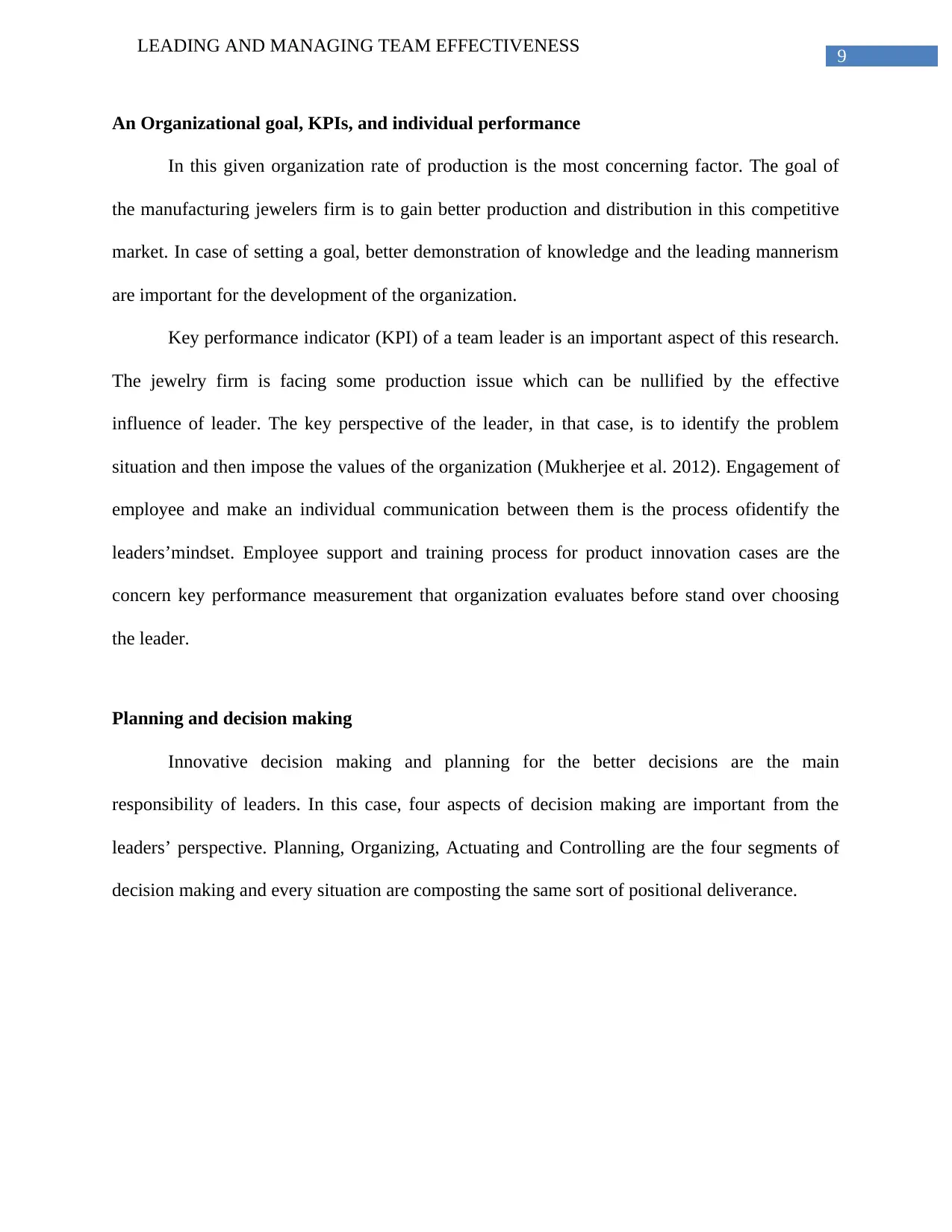
9
LEADING AND MANAGING TEAM EFFECTIVENESS
An Organizational goal, KPIs, and individual performance
In this given organization rate of production is the most concerning factor. The goal of
the manufacturing jewelers firm is to gain better production and distribution in this competitive
market. In case of setting a goal, better demonstration of knowledge and the leading mannerism
are important for the development of the organization.
Key performance indicator (KPI) of a team leader is an important aspect of this research.
The jewelry firm is facing some production issue which can be nullified by the effective
influence of leader. The key perspective of the leader, in that case, is to identify the problem
situation and then impose the values of the organization (Mukherjee et al. 2012). Engagement of
employee and make an individual communication between them is the process ofidentify the
leaders’mindset. Employee support and training process for product innovation cases are the
concern key performance measurement that organization evaluates before stand over choosing
the leader.
Planning and decision making
Innovative decision making and planning for the better decisions are the main
responsibility of leaders. In this case, four aspects of decision making are important from the
leaders’ perspective. Planning, Organizing, Actuating and Controlling are the four segments of
decision making and every situation are composting the same sort of positional deliverance.
LEADING AND MANAGING TEAM EFFECTIVENESS
An Organizational goal, KPIs, and individual performance
In this given organization rate of production is the most concerning factor. The goal of
the manufacturing jewelers firm is to gain better production and distribution in this competitive
market. In case of setting a goal, better demonstration of knowledge and the leading mannerism
are important for the development of the organization.
Key performance indicator (KPI) of a team leader is an important aspect of this research.
The jewelry firm is facing some production issue which can be nullified by the effective
influence of leader. The key perspective of the leader, in that case, is to identify the problem
situation and then impose the values of the organization (Mukherjee et al. 2012). Engagement of
employee and make an individual communication between them is the process ofidentify the
leaders’mindset. Employee support and training process for product innovation cases are the
concern key performance measurement that organization evaluates before stand over choosing
the leader.
Planning and decision making
Innovative decision making and planning for the better decisions are the main
responsibility of leaders. In this case, four aspects of decision making are important from the
leaders’ perspective. Planning, Organizing, Actuating and Controlling are the four segments of
decision making and every situation are composting the same sort of positional deliverance.
Paraphrase This Document
Need a fresh take? Get an instant paraphrase of this document with our AI Paraphraser
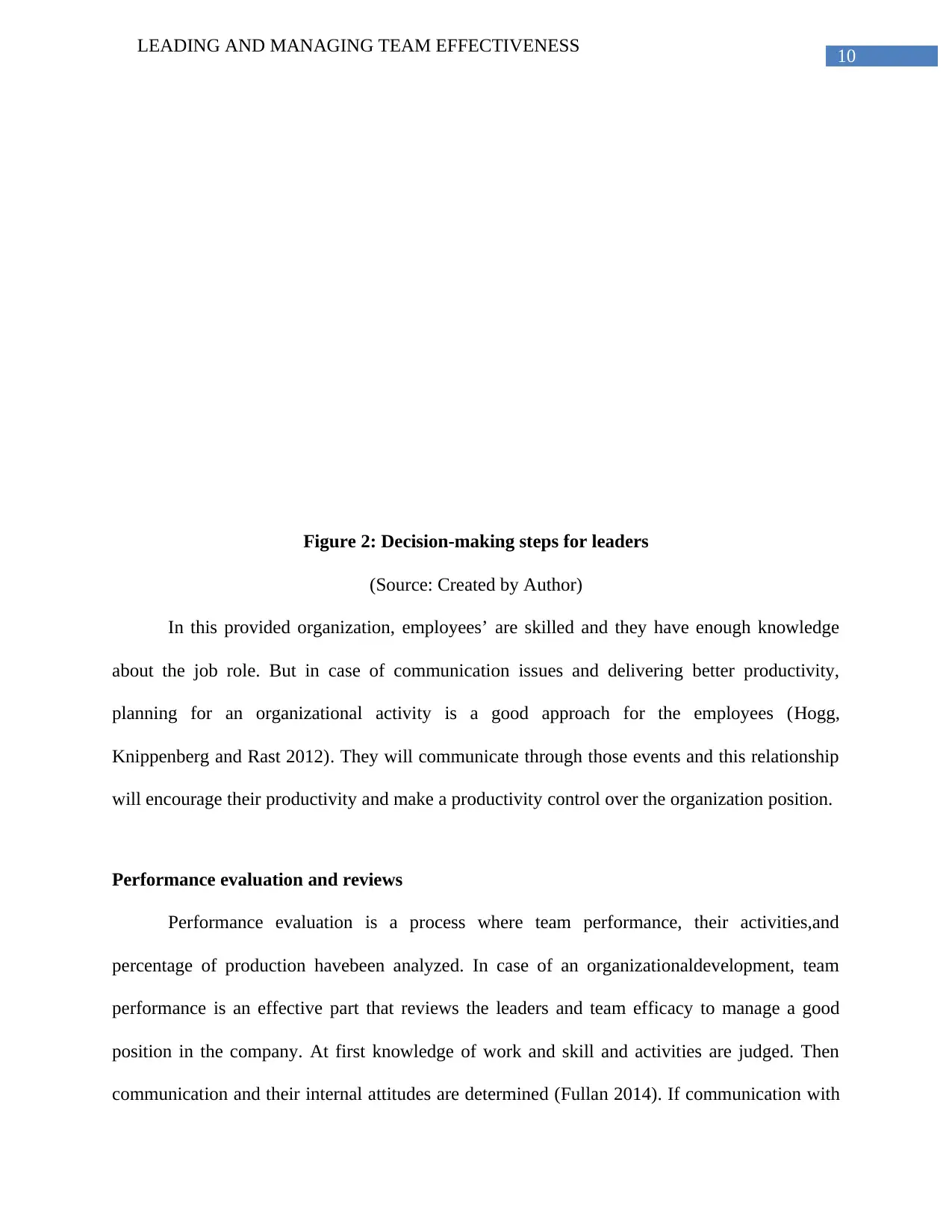
10
LEADING AND MANAGING TEAM EFFECTIVENESS
Figure 2: Decision-making steps for leaders
(Source: Created by Author)
In this provided organization, employees’ are skilled and they have enough knowledge
about the job role. But in case of communication issues and delivering better productivity,
planning for an organizational activity is a good approach for the employees (Hogg,
Knippenberg and Rast 2012). They will communicate through those events and this relationship
will encourage their productivity and make a productivity control over the organization position.
Performance evaluation and reviews
Performance evaluation is a process where team performance, their activities,and
percentage of production havebeen analyzed. In case of an organizationaldevelopment, team
performance is an effective part that reviews the leaders and team efficacy to manage a good
position in the company. At first knowledge of work and skill and activities are judged. Then
communication and their internal attitudes are determined (Fullan 2014). If communication with
LEADING AND MANAGING TEAM EFFECTIVENESS
Figure 2: Decision-making steps for leaders
(Source: Created by Author)
In this provided organization, employees’ are skilled and they have enough knowledge
about the job role. But in case of communication issues and delivering better productivity,
planning for an organizational activity is a good approach for the employees (Hogg,
Knippenberg and Rast 2012). They will communicate through those events and this relationship
will encourage their productivity and make a productivity control over the organization position.
Performance evaluation and reviews
Performance evaluation is a process where team performance, their activities,and
percentage of production havebeen analyzed. In case of an organizationaldevelopment, team
performance is an effective part that reviews the leaders and team efficacy to manage a good
position in the company. At first knowledge of work and skill and activities are judged. Then
communication and their internal attitudes are determined (Fullan 2014). If communication with
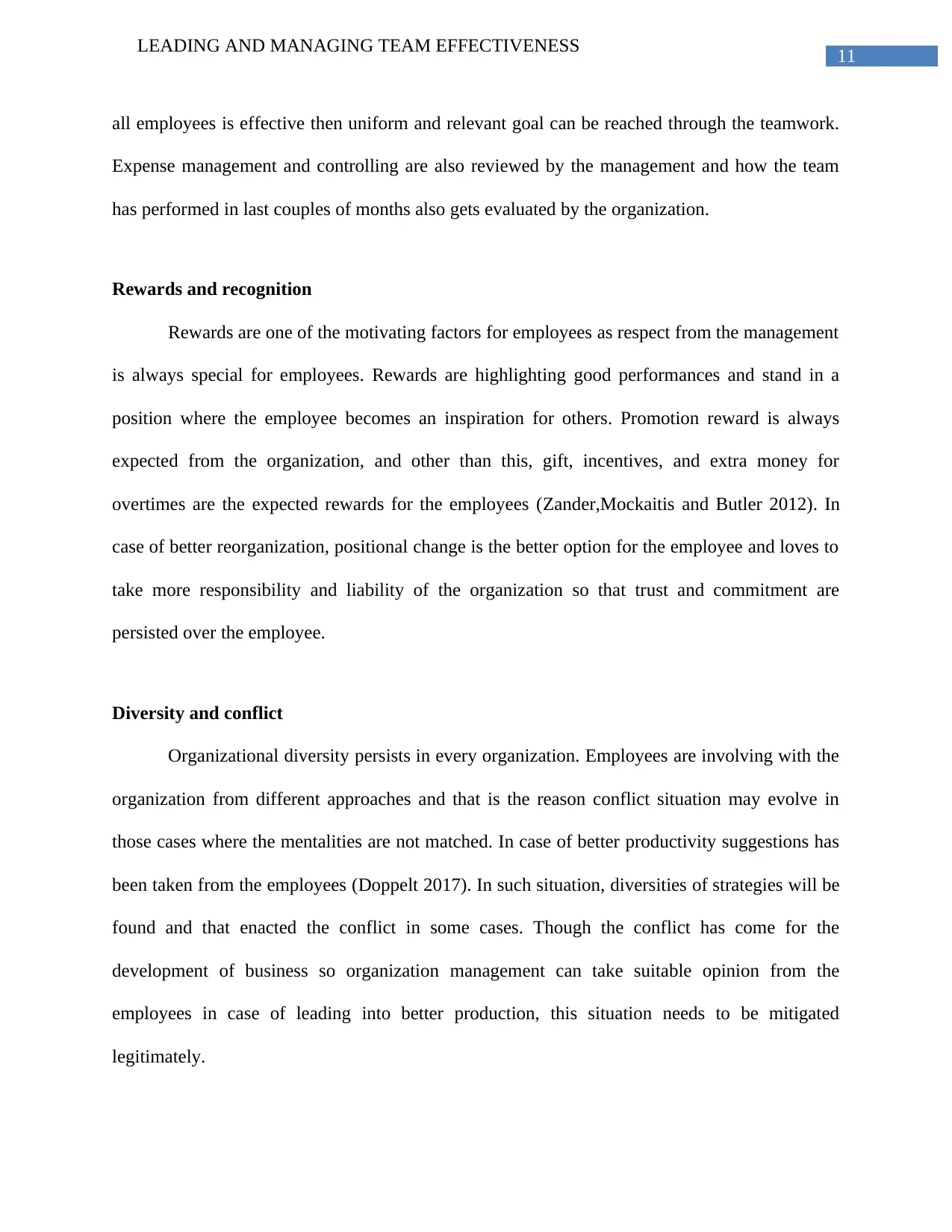
11
LEADING AND MANAGING TEAM EFFECTIVENESS
all employees is effective then uniform and relevant goal can be reached through the teamwork.
Expense management and controlling are also reviewed by the management and how the team
has performed in last couples of months also gets evaluated by the organization.
Rewards and recognition
Rewards are one of the motivating factors for employees as respect from the management
is always special for employees. Rewards are highlighting good performances and stand in a
position where the employee becomes an inspiration for others. Promotion reward is always
expected from the organization, and other than this, gift, incentives, and extra money for
overtimes are the expected rewards for the employees (Zander,Mockaitis and Butler 2012). In
case of better reorganization, positional change is the better option for the employee and loves to
take more responsibility and liability of the organization so that trust and commitment are
persisted over the employee.
Diversity and conflict
Organizational diversity persists in every organization. Employees are involving with the
organization from different approaches and that is the reason conflict situation may evolve in
those cases where the mentalities are not matched. In case of better productivity suggestions has
been taken from the employees (Doppelt 2017). In such situation, diversities of strategies will be
found and that enacted the conflict in some cases. Though the conflict has come for the
development of business so organization management can take suitable opinion from the
employees in case of leading into better production, this situation needs to be mitigated
legitimately.
LEADING AND MANAGING TEAM EFFECTIVENESS
all employees is effective then uniform and relevant goal can be reached through the teamwork.
Expense management and controlling are also reviewed by the management and how the team
has performed in last couples of months also gets evaluated by the organization.
Rewards and recognition
Rewards are one of the motivating factors for employees as respect from the management
is always special for employees. Rewards are highlighting good performances and stand in a
position where the employee becomes an inspiration for others. Promotion reward is always
expected from the organization, and other than this, gift, incentives, and extra money for
overtimes are the expected rewards for the employees (Zander,Mockaitis and Butler 2012). In
case of better reorganization, positional change is the better option for the employee and loves to
take more responsibility and liability of the organization so that trust and commitment are
persisted over the employee.
Diversity and conflict
Organizational diversity persists in every organization. Employees are involving with the
organization from different approaches and that is the reason conflict situation may evolve in
those cases where the mentalities are not matched. In case of better productivity suggestions has
been taken from the employees (Doppelt 2017). In such situation, diversities of strategies will be
found and that enacted the conflict in some cases. Though the conflict has come for the
development of business so organization management can take suitable opinion from the
employees in case of leading into better production, this situation needs to be mitigated
legitimately.
⊘ This is a preview!⊘
Do you want full access?
Subscribe today to unlock all pages.

Trusted by 1+ million students worldwide
1 out of 19
Related Documents
Your All-in-One AI-Powered Toolkit for Academic Success.
+13062052269
info@desklib.com
Available 24*7 on WhatsApp / Email
![[object Object]](/_next/static/media/star-bottom.7253800d.svg)
Unlock your academic potential
Copyright © 2020–2025 A2Z Services. All Rights Reserved. Developed and managed by ZUCOL.





